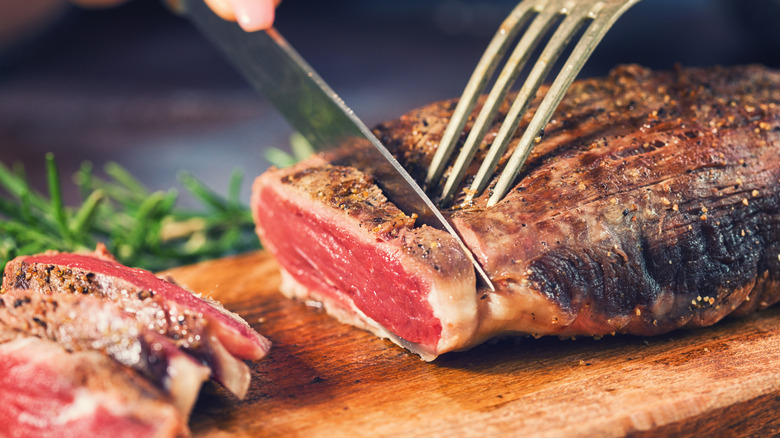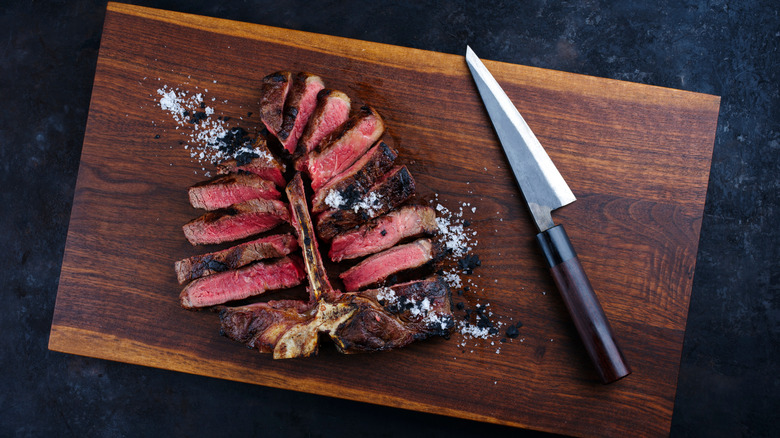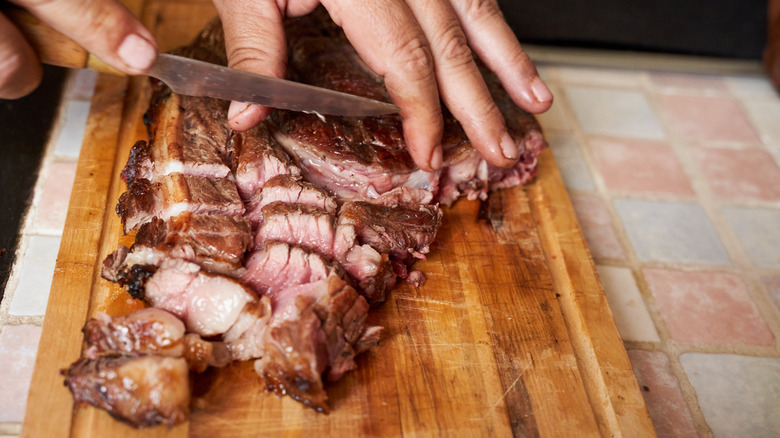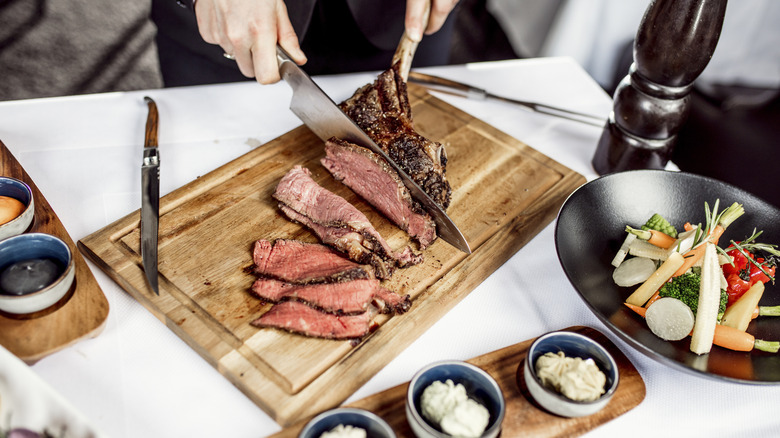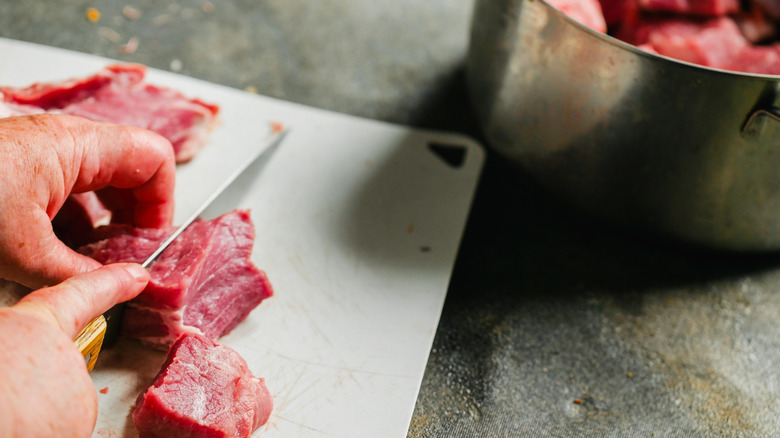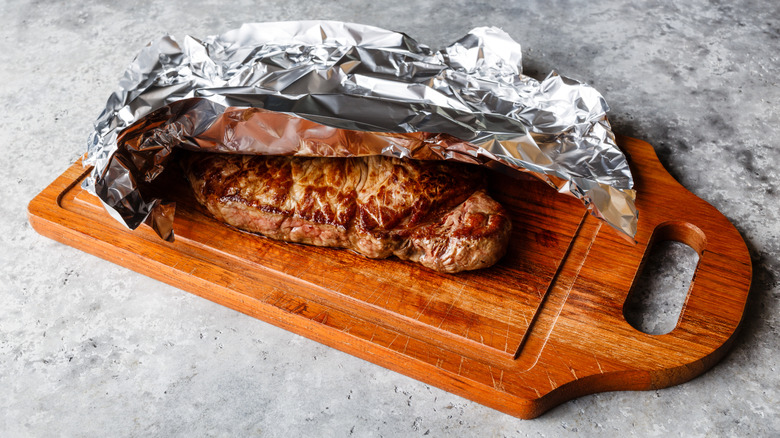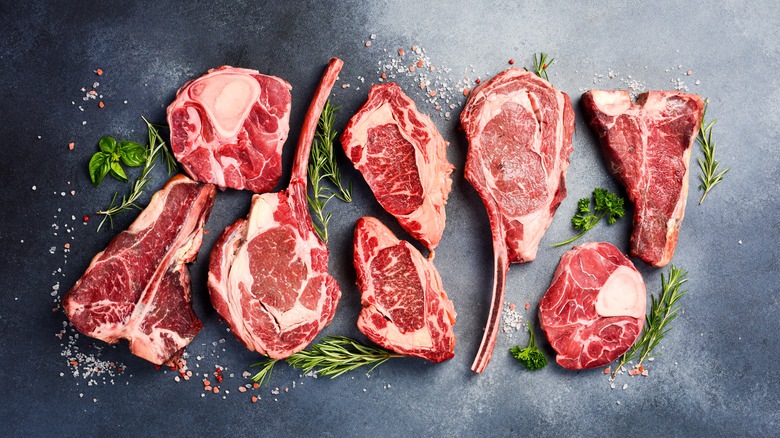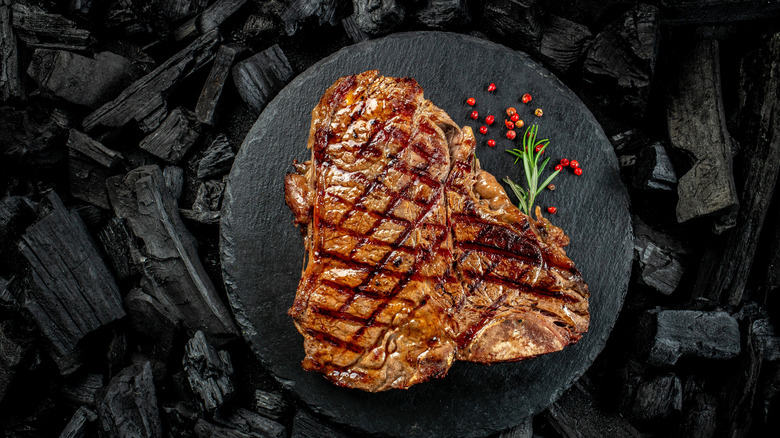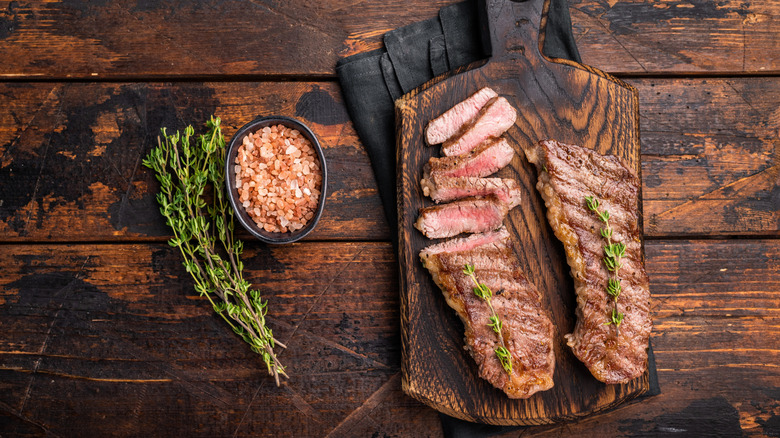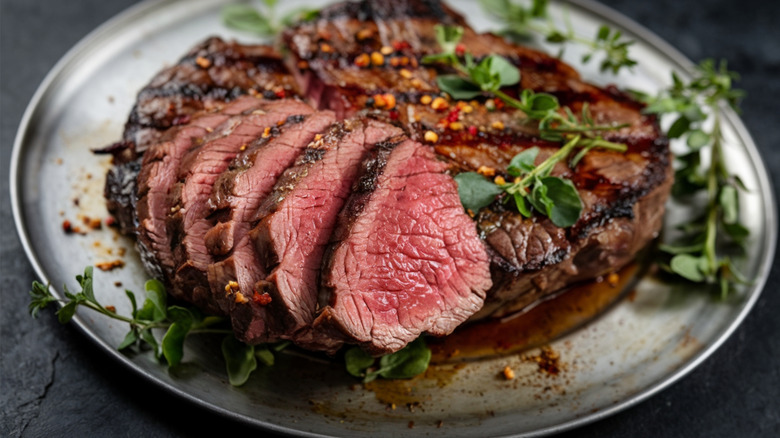Mistakes Everyone Makes When Slicing Steak, According To The Experts
While many home cooks obsess over cooking temperatures and seasoning techniques, the art of properly slicing steak often gets overlooked. Food Republic spoke to three experts to get all the tips and tricks on slicing the perfect steak. Executive chef Kylian Goussot of Lafayette Steakhouse in Miami, brings Michelin starred expertise. At his restaurant premium cuts from America's finest family-owned farms are cooked over a wood charcoal Josper oven. We also spoke to chef William Eick who takes steak presentation seriously at his modern Japanese restaurant Matsu in Oceanside, California. There, diners are presented with a selection of locally made steak knives to use on the A5 Wagyu. And finally, Justin Owens offers us another perspective as co-owner of Manzo Piedmontese, a private beef label specializing in ultra-luxury beef from the Italian Piedmontese cattle breed.
Whether you're serving a premium ribeye or a humble flank steak, mastering a few techniques for slicing will elevate your steak game from amateur to professional. We've asked these experts to guide us through the most common steak slicing pitfalls and how to avoid them.
Not slicing against the grain
One of the most common mistakes when slicing steak happens before your knife even touches the meat. Many home cooks don't pay attention to the grain of the steak or understand why cutting against it matters. And while making this mistake won't affect the flavor, it will have a big impact on the steak's tenderness. Executive chef Kylian Goussot, Lafayette Steakhouse, explains, "Long, intact muscle fibers can make the meat chewy. By slicing perpendicular to the fibers, you shorten them, making each bite more tender."
The grain can be harder to spot in some cuts than others. There are two main factors at play here. According to chef William Eick, Matsu, muscles that experience more movement tend to develop more visible grain patterns. Goussot explains that cuts like brisket, flank steak, and bavette showcase distinct grain because their muscle fibers grow longer and more defined. In comparison, more tender cuts such as filet mignon feature less pronounced grain patterns.
The cattle breed also plays a significant role in grain visibility. Justin Owens, co-owner of Manzo Piedmontese, notes that variations in collagen content and intramuscular fat across different breeds directly impact how noticeable the grain appears. Wagyu breeds including Kuroge and Akaushi contain abundant intramuscular fat that surrounds their large muscle fibers, which actually makes the grain less visible. On the other hand, breeds like Fassona from Northern Italy develop tiny muscle fibers with minimal collagen and virtually no fat, resulting in more visible, packed-in fiber structures.
Taking a moment to identify the grain direction before you start slicing pays dividends in tenderness. If you're unsure, try a small test cut and observe how the meat fibers appear on the cut surface.
Using a dull knife
If you've ever struggled to slice through a beautifully cooked steak, the culprit might not be your technique, but rather the tool in your hand. Many home cooks underestimate just how much knife sharpness affects both the presentation and texture of sliced steak.
Matsu chef William Eick gets straight to the point, "The best knife will always be the sharpest one." When your knife lacks proper sharpness, it tears and shreds the meat fibers instead of cleanly slicing through them. This doesn't just look messy, it also makes your steak less enjoyable to eat. Justin Owens of Manzo Piedmontese agrees: "The main goal is not mangling the meat, so being sharp and precise is the name of the game." A sharp knife allows you to make clean cuts that preserve the meat's texture and juiciness.
Executive chef Kylian Goussot, Lafayette Steakhouse, recommends high-quality stainless steel or carbon steel blades as they maintain a sharp edge longer and provide better control when slicing. There are plenty of ways to keep your knives nice and sharp. Ina Garten's secret weapon is the the Chef's Choice Model 320 Flexhone/Strop Pro Knife Sharpener which will have your knives looking brand new with each sharpen. Alternatively, see if there are professionals in your area that provide the service — there are some grocery stores that will do it for you. You could also try this trick using the underside of a plate.
While a well-sharpened chef's knife or slicing knife works excellently for most steaks, serrated knives have their place. Owens notes that serrated knives can be helpful with grilled cuts that have a thicker crust. For everything else, it won't be suitable, as Eick points out, "The serrated (knife) causes the meat to move more, which will force the juices out of the steak more easily, resulting in a drier bite."
Not using a 45 degree angle
Don't cut straight down through your steak. According to executive chef Kylian Goussot the angle of your knife plays a key role in both the texture and appearance. He recommends using a 45-degree angle when cutting. This will create wider, more tender slices that makes the steak appear more substantial and appealing on the plate.
Identify the grain direction in your steak first and then position your knife at a 45-degree angle to your cutting board while keeping it perpendicular to those grain lines. A sharp knife is essential for this technique. With your blade positioned correctly, apply gentle, steady pressure as you slice through the meat. The angled cut creates wider, more substantial looking slices that display more surface area on the plate. As you continue cutting, maintain that same 45-degree angle consistently for each slice.
The increased surface area also distributes the seasoned exterior of your steak across more of each slice, giving you more flavor in every bite. Don't worry if your first attempts aren't perfectly uniform. Start slowly and focus on maintaining the angle rather than speed.
Short and choppy slicing
Avoid hacking away at the steak with short, back and forth chops. As Justin Owens, co-owner of Manzo Piedmontese, explains, "Lots of short slices leaves cuts very unattractive, and sends the message that the meat is tough." Those uneven edges will look unprofessional. When diners (even in guests in your home) see ragged, inconsistent slices, they subconsciously judge the steak as lower quality or improperly prepared, even if it's cooked perfectly. There is merit to the old saying, we really do eat with our eyes.
Executive chef Kylian Goussot, Lafayette Steakhouse in Miami, recommends using a smooth, continuous motion. Imagine slicing through your steak with the same grace and precision as a surgeon, each stroke deliberate and controlled. With practice, this technique becomes second nature and the results speak for themselves: Elegant, restaurant-quality slices that show your steak's perfect doneness and juicy interior. Your guests might not be able to articulate exactly what makes your steak presentation so appealing, but they'll definitely notice the difference between a haphazardly chopped piece of meat and one sliced with deliberate, clean strokes.
Applying too much pressure
Applying a lot of downward pressure on your knife might seem like the right approach to get through a thick steak, but it actually works against you. This common error can affect both texture and juiciness.
When you press down too hard while cutting steak, you're essentially squeezing the meat and forcing out those precious, flavorful juices that make each bite succulent. Kylian Goussot, executive chef, recommends using a gentle touch with your knife, letting the blade's sharpness do the work without compressing the steak's structure.
Hold your knife with a relaxed but controlled grip, applying just enough pressure to maintain contact with the meat. Let the knife's sharp edge glide through the steak rather than forcing it. If you find yourself pressing hard, it's usually a sign that your knife needs sharpening. A proper cutting motion feels almost effortless, with the weight of the knife and minimal guidance doing most of the work.
Storing sliced steak incorrectly
Even the most perfectly cooked and beautifully sliced steak can quickly lose its magic with improper storage. Let's face it, we've all had that disappointing experience of opening the fridge the next day to find our gorgeous steak looking ... well, not so gorgeous anymore. The good news? A few simple storage tweaks can make all the difference.
When it comes to steak that's been sliced but not yet cooked, time and air are your biggest enemies, chef William Eick, Matsu, puts it simply, "... the meat will oxidize quickly, and the red color will turn grey." Since sliced steak has more surface area exposed to air, these changes happen much faster than with whole cuts.
Eick recommends keeping sliced steak in an airtight container in the refrigerator. For even better protection, executive chef Kylian Goussot, Lafayette Steakhouse, suggests wrapping your steak tightly in plastic wrap or vacuum-sealing it to preserve its quality. These methods minimize air contact, which is crucial for maintaining both appearance and flavor of sliced steak.
If you follow these steps, raw steak should last for up to five days in the fridge, with cooked steak lasting about three or four days. Think of proper storage as the final step in your steak preparation ritual. Those extra few minutes of care will mean all the effort you put into selecting and preparing that perfect cut won't go to waste.
Not letting it rest
You've monitored the temperature perfectly, achieved that beautiful sear, and now you're eager to slice into your steak and enjoy the fruits of your labor. But wait. Skipping the crucial resting period is a common mistake that can turn your masterpiece into a disappointing puddle of juices.
"When I worked in Michelin-starred kitchens, the chefs would always say: cooking time = resting time," says executive chef Kylian Goussot. "This is a golden rule for ensuring a juicy steak. However, for everyday cooking at home, it's generally recommended to let the steak rest for 5 to 10 minutes after cooking." This allows the juices to redistribute evenly throughout the meat, preventing them from escaping immediately when sliced, resulting in a more tender texture and preserved flavor. Justin Owens, co-owner of Manzo Piedmontese, offers more specific guidance based on the type of meat. He notes that leaner cuts with less fat and collagen, like those from the Fassona breed, cook faster and need the least time, just five minutes will do.
Patience at this stage pays enormous dividends. Those few extra minutes might feel like torture when your mouth is watering, but they're the difference between good steak and great steak.
Not taking the cut into account
Not all steaks are created equal, and treating them as if they are will lead to disappointment. An overlooked aspect of steak slicing is adjusting your technique based on the specific cut you're working with. Each different steak cut has its own unique muscle structure, tenderness level, and grain pattern, all of which should influence how you approach slicing it.
Executive chef Kylian Goussot of Lafayette Steakhouse in Miami explains that, "Different cuts require different slicing methods. Cuts with pronounced muscle fibers such as flank steak or bavette must be sliced perpendicular to the grain for maximum tenderness. For ribeye or strip steak, slicing at a slight angle is often best for an optimal texture." This makes perfect sense when you consider the vast differences between steak cuts. A tender filet mignon with its fine, almost imperceptible grain requires different handling than a flank steak with its long, distinct muscle fibers. When you slice each cut correctly, you're bringing out the best in that particular steak's natural qualities.
Learning the specific characteristics of different steak cuts is a culinary skill worth developing. Each cut tells you how it wants to be sliced if you know how to read its muscle structure.
Mishandling bone-in steaks
Bone-in steaks like T-bones and porterhouses offer amazing flavor. The bone is bad at conducting heat so meat near it cooks more slowly and ends up more tender and juicy. But these cuts can be tricky since the grain often runs in different directions on each side. So how do you tackle this type of steak?
Executive chef Kylian Goussot shares the perfect technique, "For these cuts, it's best to start by removing the meat from the bone, following its curve with the tip of the knife. Then, slice the tenderloin and strip steak separately into thin pieces, cutting against the grain for tenderness and ease of eating."
Following the bone's natural curve requires patience and a gentle touch. Start at one end and work your way along, keeping your knife close to the bone surface. Try not to rush this process, taking your time will result in more meat on your plate and less left on the bone. Your goal is to preserve as much meat as possible while creating clean, beautiful slices.
Once you've separated the meat from the bone, take a moment to identify the grain direction on each portion before slicing. Remember that the tenderloin side typically has a different grain pattern than the strip side. Adjust your cutting angle accordingly for each section. The next time you're at a restaurant and they bring out that porterhouse steak, you'll know exactly how to approach it with confidence and skill.
Mishandling tri-tip
Tri-tip is probably the most tricky cut to slice. It has muscle fibers that run in multiple directions rather than neatly aligning in a single pattern. This naturally occurring variation happens because this cut comes from an area where different muscle groups converge.
When you're dealing with a standard cut with consistent grain direction, the "cut against the grain" rule is straightforward. But what happens when the grain shifts direction halfway through the cut? If you maintain the same slicing angle throughout, some portions will be cut against the grain while others will inadvertently be cut with the grain. The result is oddly inconsistent texture, with some bites being tender and others noticeably tougher.
You can identify changing grain directions by looking carefully at the meat's surface. The muscle fibers appear as subtle lines or striations. When you notice these lines changing direction or orientation across different areas of the cut, you're dealing with multiple grain patterns. This is particularly common in tri-tip, which typically has two or three distinct grain sections due to its triangular shape and position at the bottom of the sirloin.
Chef William Eick, Matsu, offers a practical solution for handling these tricky cuts. He recommends breaking "these cuts down into larger pieces that all have the grain facing the same direction, then slice from there."
Different Cuts Need Different Thickness
You should adjust your slicing thickness depending on the cut of meat. Executive chef Kylian Goussot, Lafayette Steakhouse in Miami, explains that this approach can enhance tenderness, improve texture, and preserve juiciness and flavor. He let's us in on how the professionals do it.
For naturally tender cuts like filet mignon and strip steak, go with medium slices about 1 centimeter or ⅜ inch thick. This thickness keeps them tender while locking in all those tasty juices. The medium slice provides the perfect balance between texture and moisture retention, giving you that restaurant quality experience at home.
When working with tougher cuts like flank steak or bavette, slice them thinner, about a ½ centimeter or ¼ inch thick. This clever trick makes these cuts much easier to chew by shortening those muscle fibers. Your potentially chewy steak becomes deliciously tender. The thinner slices compensate for the natural toughness while still showcasing the robust flavor these cuts are known for.
For those juicy, fatty cuts everyone loves, like tomahawk and ribeye, go thicker with ⅝-inch slices. The extra thickness lets all that beautiful marbling shine and carries amazing flavor in every bite. These generous slices allow you to experience the full impact of the rich fat distribution that makes these premium cuts so desirable.

